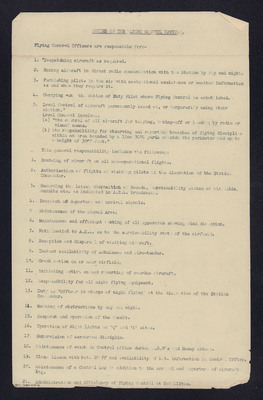Duties of the flying control officer
Title
Duties of the flying control officer
Description
Lists specific and general responsibilities of flying control officers.
Coverage
Language
Format
One page typewritten document
Publisher
Rights
This content is available under a CC BY-NC 4.0 International license (Creative Commons Attribution-NonCommercial 4.0). It has been published ‘as is’ and may contain inaccuracies or culturally inappropriate references that do not necessarily reflect the official policy or position of the University of Lincoln or the International Bomber Command Centre. For more information, visit https://creativecommons.org/licenses/by-nc/4.0/ and https://ibccdigitalarchive.lincoln.ac.uk/omeka/legal.
Contributor
Identifier
MSoltysiakB781032-170622-36
Transcription
[underlined] DUTIES OF THE FLYING CONTROL OFFICER. [/underlined]
Flying Control Officers are responsible for:-
1. "Despatching aircraft as required.
2. Homing aircraft in direct radio communication with the Station by day and night.
3. Furnishing pilots in the air with navigational assistance or weather information as and when they require it.
4. Carrying out the duties of Duty Pilot where Flying Control is established.
5. Local Control of aircraft permanently based on, or temporarily using their station."
Local Control involves:
(a) "the control of all aircraft for taxying, taking-off or landing by radio or visual means.
(b) the responsibility for observing and reporting breaches of flying discipline within an area bounded by a line 3000 yards outside the perimeter and up to a height of 3000 feet."
This general responsibility includes the following:
1. Routeing of aircraft on all non-operational flights.
2. Authorisation of flights of visiting pilots at the discretion of the Station Commander.
3. Recording the latest disposition of Nomads, serviceability states of airfields, occults etc. as indicated in A.S.4. broadcasts.
4. Despatch or departure and arrival signals.
5. Maintenance of the Signal area.
6. Maintenance and efficient working of all apparatus showing wind direction.
7. Notification to A.S.4. as to the serviceability state of the airfield.
8. Reception and dispersal of visiting aircraft.
9. Instant availability of Ambulance and Fire-tender.
10. Crash action on or near airfield.
11. Initiating action on and reporting of overdue aircraft.
12. Responsibility for all night flying equipment.
13. Duty as 'Officer in charge of night flying at the discretion of the Station Commander.
14. Marking of obstructions by day and night.
15. Despatch and operation of the Pundit.
16. Operation of Night Lights on 'Q' and 'K' sites.
17. Supervision of aerodrome discipline.
18. Maintenance of watch in Control Office during A.R.W's and Enemy attack.
19. Close liason [sic] with Met. Staff and availability of Met. information in Control Office.
20. Maintenance of a Control Log in addition to the arrival and departure of aircraft log.
21. Administration and Efficiency of Flying Control at Satellites.
Flying Control Officers are responsible for:-
1. "Despatching aircraft as required.
2. Homing aircraft in direct radio communication with the Station by day and night.
3. Furnishing pilots in the air with navigational assistance or weather information as and when they require it.
4. Carrying out the duties of Duty Pilot where Flying Control is established.
5. Local Control of aircraft permanently based on, or temporarily using their station."
Local Control involves:
(a) "the control of all aircraft for taxying, taking-off or landing by radio or visual means.
(b) the responsibility for observing and reporting breaches of flying discipline within an area bounded by a line 3000 yards outside the perimeter and up to a height of 3000 feet."
This general responsibility includes the following:
1. Routeing of aircraft on all non-operational flights.
2. Authorisation of flights of visiting pilots at the discretion of the Station Commander.
3. Recording the latest disposition of Nomads, serviceability states of airfields, occults etc. as indicated in A.S.4. broadcasts.
4. Despatch or departure and arrival signals.
5. Maintenance of the Signal area.
6. Maintenance and efficient working of all apparatus showing wind direction.
7. Notification to A.S.4. as to the serviceability state of the airfield.
8. Reception and dispersal of visiting aircraft.
9. Instant availability of Ambulance and Fire-tender.
10. Crash action on or near airfield.
11. Initiating action on and reporting of overdue aircraft.
12. Responsibility for all night flying equipment.
13. Duty as 'Officer in charge of night flying at the discretion of the Station Commander.
14. Marking of obstructions by day and night.
15. Despatch and operation of the Pundit.
16. Operation of Night Lights on 'Q' and 'K' sites.
17. Supervision of aerodrome discipline.
18. Maintenance of watch in Control Office during A.R.W's and Enemy attack.
19. Close liason [sic] with Met. Staff and availability of Met. information in Control Office.
20. Maintenance of a Control Log in addition to the arrival and departure of aircraft log.
21. Administration and Efficiency of Flying Control at Satellites.
Collection
Citation
“Duties of the flying control officer,” IBCC Digital Archive, accessed July 27, 2024, https://ibccdigitalarchive.lincoln.ac.uk/omeka/collections/document/35288.
Item Relations
This item has no relations.

